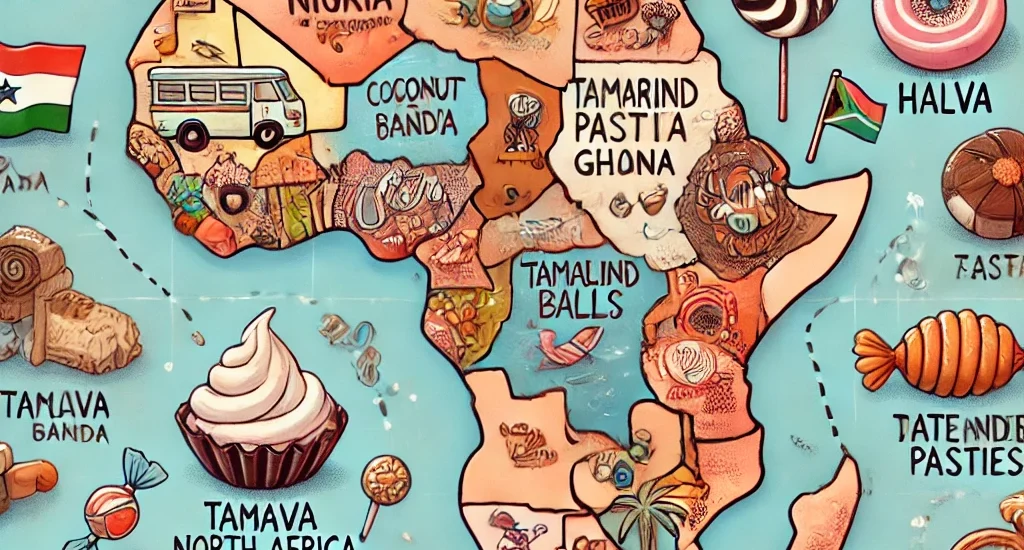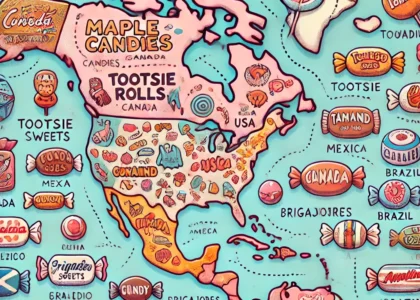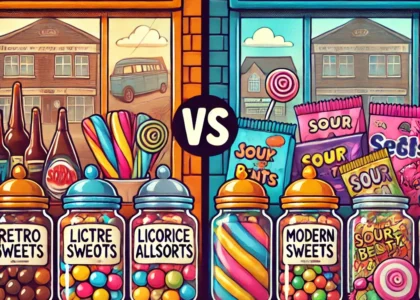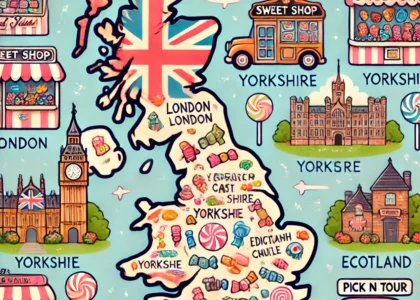Introduction: Africa’s Sweet Tooth Through the Ages
While Africa may be better known for its savory street food, vibrant spices, and fresh produce, the continent also has a deep-rooted sweet culture that spans decades and generations. Retro sweets — some homemade, others locally produced — have played an essential role in childhood memories, festive traditions, and everyday indulgence.
Whether it’s the chewy taffy sold by street vendors in Ghana or the fizzy sherbets of South Africa’s townships, Africa’s nostalgic candies offer a glimpse into the past. In this article, we journey across the continent to uncover the best retro sweets from various African countries — sweets that defined school days, celebrations, and simple joys.
South Africa: Fizzers and Wilson’s Toffees
South Africa’s confectionery scene blends British colonial influences with local creativity. Retro favourites include:
- Fizzers – fruity, chewy sticks that kids loved to freeze or snap in half.
- Wilson’s Toffees – iconic chewy toffees in classic flavors like banana, strawberry, and mint.
- Sweetie Pie – marshmallow domes covered in chocolate, often eaten in one messy bite.
- Chappies – bubble gum with trivia printed inside the wrapper — a true cultural icon.
- Zoo Biscuits – animal-shaped iced biscuits often served at birthday parties.
Many of these sweets are still available, evoking strong memories for generations of South Africans.
Nigeria: Tom Tom and Baba Dudu
In Nigeria, sweet treats were often both delicious and functional — used to soothe, entertain, or reward. Popular retro options include:
- Tom Tom – menthol candies used by singers, students, and commuters to clear throats and freshen breath.
- Baba Dudu – dark, molasses-based coconut candy sticks, often homemade or sold in clear wrappers.
- Ekana Gowon – old-school peanut candies made by rolling sugar and peanuts into small balls.
- Pako – sweetened cassava starch jelly, sometimes wrapped in leaves.
- Ajabọ – sticky tamarind sweets with chili, found in northern Nigeria.
These sweets were often purchased from street hawkers or local “mama put” stalls after school.
Ghana: Toffee and Poloo
Ghanaian retro sweets often blur the line between snack and dessert — simple, homemade, and deeply nostalgic.
- Ghana Toffee – brightly wrapped, hard candies with fruity or caramel flavors.
- Poloo (fried coconut dough balls) – technically a snack, but sweet enough to be a dessert treat.
- Nkati Cake – peanut brittle made by heating sugar and mixing with roasted groundnuts.
- Abele Walls – local brand of ice cream and frozen lollies sold in plastic sachets, especially popular in the 80s and 90s.
- Bofrot – sweet fried dough balls (like doughnut holes) commonly eaten after school.
Though not all mass-produced, many of these sweet treats are widely remembered as part of childhood.
Kenya: Big G Gum and Mabuyu
Kenya’s retro sweets reflect local ingredients, entrepreneurial spirit, and street culture.
- Big G Chewing Gum – bright red bubble gum, once the most popular in East Africa.
- Mabuyu – baobab seeds coated in red sugar, often spiced and sold in small packets.
- Kashata – coconut or peanut bars made with caramelized sugar, often eaten during Ramadan.
- Toffee Sweets – fruity and creamy hard toffees sold at kiosks in colorful wrappers.
- Njugu Karanga Sweets – sugared peanuts, often roasted and glazed by hand.
You’d often find these sold outside schools, in matatus (minibuses), or at open-air markets.
Ethiopia: Kolo and Traditional Sugarcane
Ethiopia’s sweets reflect its ancient culture and rural traditions:
- Kolo – a mix of roasted barley, chickpeas, and peanuts, often sweetened with honey or sugar.
- Chikichika – chewy candy balls made from reduced fruit syrup.
- Tella Sugarcane – children would chew on sugarcane strips sold by local vendors.
- Local honey sticks – a common snack among children during market days.
- Boiled coffee candies – sweet, caffeinated hard candies influenced by Ethiopia’s coffee heritage.
In Ethiopia, many “sweets” are more rustic and seasonal, but no less nostalgic.
Egypt: Mehalabiya Flavored Lollipops and Halawa Bars
Egypt’s love for sweets is ancient — from Pharaonic honey treats to post-colonial confections:
- Halawa Bars – sweet tahini-based treats, sometimes with pistachios or chocolate.
- Mehalabiya-flavored lollipops – inspired by traditional milk pudding.
- Freska – chocolate wafers often sold on the beach or at street stalls.
- Malban – chewy fruit candies rolled in powdered sugar and sometimes filled with nuts.
- Simsimiyya – sesame bars sweetened with honey or molasses.
Retro sweets are tied to religious festivals and traditional street snacks.
Morocco: Sfenj and Chebakia (Sweet Pastry Sweets)
Moroccan retro sweets often come in pastry form, sold at local souks and family kitchens.
- Sfenj – deep-fried doughnuts sprinkled with sugar, often eaten hot.
- Chebakia – sesame cookies coated in honey and orange blossom, traditionally eaten during Ramadan.
- Hard Mint Sweets – sold in twist wraps, often handed out to kids at shops.
- Halwa Torkia – a dense, sesame-based sweet similar to halva.
- Caramel Sticks and Date Paste Balls – regional favorites often made at home.
Though not factory-made “candy,” these are the go-to retro treats across Morocco.
Senegal: Bouye and Peanut Sweets
Senegal’s sweets are inspired by local fruits and nut traditions:
- Bouye Candy – made from the baobab fruit (bouye), sweetened and sometimes mixed with milk.
- Dakkar Sweets – peanut and millet-based treats that resemble brittle.
- Mint Drops – common in Islamic households after prayers or during celebrations.
- Tamarind Chews – sticky, tart candies sold in twisty paper wrappings.
- Bissap Sweets – hibiscus-based candies or syrups turned into hard sweets.
Much like in West Africa overall, sweets often double as digestives or festive gifts.
Sudan: Sesame Brittle and Milk Halawa
In Sudan, the desert climate inspires sweets that last long and pack flavor:
- Simsimiyya – sesame brittle bars, found in homes and markets.
- Milk Halawa – sweet milk-based candy that melts in your mouth.
- Ginger Chews – strong and spicy, used for both taste and medicinal purposes.
- Date Candies – made by reducing dates into paste and rolling with coconut.
- Nabat – crystallized sugar sticks, similar to rock candy.
Sudanese sweets often feel medicinal, yet children adored them for their sweetness.
Tanzania: Baobab and Coconut Candies
Tanzania’s sweets are locally sourced and often sold by informal vendors:
- Baobab Candy – powdered or candied baobab mixed with chili and sugar.
- Coconut Bites – caramelized coconut pieces.
- Tamarind Toffee – sticky, dark, and packed with flavor.
- Mishikaki Sweets – candy on skewers, mimicking the style of grilled meats.
- Sweetened Plantain Chips – lightly sugared and crunchy.
You’ll often find these at bus stops, coastal markets, and school gates.
Zambia and Zimbabwe: Raspers and Peanut Brittle
In southern Africa, simplicity and availability defined retro sweets:
- Raspers – hard, colorful candy drops sold by weight.
- Peanut Brittle (Kanyenya) – sugar and peanut slabs.
- Toffee Squares – chewy, milk-based candies wrapped in wax paper.
- Milk Sweets – condensed milk candies often made at home.
- Ice Lollies in Plastic Tubes (Freezits) – sold frozen during hot summers, more drinkable than chewable.
Children across townships and villages shared these on dusty playgrounds and school fields.
Conclusion: A Continent Full of Sweet Memories
Africa’s retro sweets are deeply woven into cultural memory — some handmade, some mass-produced, but all unforgettable. Whether it’s sucking on a spicy baobab seed in Kenya, unwrapping a Chappie in Cape Town, or sharing tamarind chews in Nigeria, each country has its own sugary signature.
Unlike globalized candy brands, African retro sweets are often personal, local, and communal — passed down through hands, not just shelves. In a continent of vast diversity, one thing unites us all: the simple joy of a childhood sweet.





